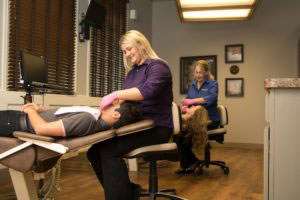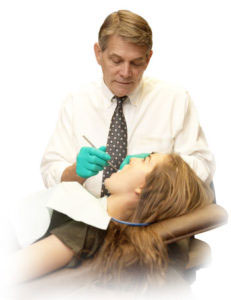How do I know if my child is in need of orthodontic treatment?
It is usually difficult for you to determine if treatment is necessary because there are many problems that can occur even though the front teeth look straight. Also, there are some problems that look intimidating and complex which will resolve on their own. Asking your general dentist is good reference, but we are your best resource since orthodontics is all we do. Our initial exam is complimentary and we would be more than happy to see your child and make any recommendations necessary.
What are the early symptoms of orthodontic problems?
Although determining if treatment is necessary is difficult for you to assess, the following symptoms may help in prompting you to seek our orthodontic advice.
Ask your child to open their mouth, and let you look at their teeth. If you see any signs of crooked teeth, gaps between your child’s teeth or overlapping teeth, your child may need orthodontic treatment.
Ask your child to bite all the way down, but keeping their lips open so you can see their teeth. Do the front top teeth line up with the bottom? Do the top teeth protrude out away from the bottom teeth? Do the top front teeth cover more than 50% of the bottom teeth? Are the top teeth behind the bottom teeth? All these are indicators for potential orthodontic treatment.
Look at the alignment of your child’s jaw. Does the jaw shift off center when your child bites down? If you see any misalignment or shifting of the jaw, your child may have a skeletal problem, which requires early orthodontic intervention.
These are only some of the obvious symptoms of orthodontic problems.
What age should my child be seen by an orthodontist?
The American Association of Orthodontists recommends that your child be evaluated by age seven. Early detection of some orthodontic problems is important in order to take early corrective action and avoid more difficult treatment later.
Can you be too old for braces?
No, age is not a factor, only the health of your gums and bone which support your teeth. About 25% of our orthodontic patients are adults and that number is still growing!

Will it hurt?
Orthodontic treatment has improved dramatically. As a rule, braces make your teeth sore for a few days, but it is not painful. This annoyance can be relieved with an over-the-counter pain reliever. Today’s braces are smaller, more comfortable and use technology that reduces the discomfort. We use the latest in miniature braces and the highest quality of orthodontic materials in order to reduce discomfort and treatment time.
Can I still have braces if I have missing teeth ?
Yes. When teeth are missing, adjacent teeth will drift into the empty space. This will cause a functional, esthetic or periodontal problem. Orthodontic treatment will correct and prevent these problems from happening and will also provide proper alignment for your dentist to replace the missing teeth.
Questions About Treatment
What is Phase I (Interceptive Treatment) and Phase II treatment?
Phase I or Interceptive Treatment usually starts while the child has most of their baby teeth and a few of their permanent front incisors. This stage in development is usually about the age of seven. The goal of Phase I treatment is to intercept a moderate or severe orthodontic problem early in order to reduce or eliminate it. These problems include skeletal dysplasias, crossbites and crowding. Phase I treatment takes advantage of the early growth spurt and turns a difficult orthodontic problem into a more manageable one. This helps reduce the need for extractions or surgery and delivers better long term results and treatment options. Most Phase I patients require a Phase II treatment in order to achieve an ideal bite.
Phase II treatment usually occurs a number of years later. Usually we are waiting for 12-16 more permanent teeth to erupt before Phase II begins. This most commonly occurs at the age of 12 or 13. The goal of Phase II treatment is to achieve an ideal occlusion with all of the permanent teeth.
What is Full or Comprehensive Orthodontic Treatment?
This is another name for orthodontic treatment in the permanent dentition at any age. It is more commonly used when a Phase I treatment was not performed.
Does everyone need a Phase I treatment?
Absolutely not! Only certain bites require early intervention. All others can wait until most if not all their permanent teeth erupt.
Can I wait on Phase I/Interceptive Orthodontic Treatment until my child is older?
This is not recommended. If your child needs Phase I treatment this usually means that he has a difficult problem that requires attention now. If no orthodontic action is taken, treatment options become limited, more difficult, and the long term stability may be compromised. In addition, it may lead to extractions, oral surgery and increase costs.
What is the length or duration of orthodontic treatment?
Braces may be on between 6 months to 30 months, or longer depending on the age of the patient, the severity of the problem, the patient’s cooperation, and the degree of movement possible.

What are extraction and non-extraction therapy, and what are the advantages and disadvantages of each?
Extraction therapy is a technique where some teeth are removed to make room for the other teeth in your child’s mouth. This is in contrast to non-extraction therapy where one expands a patients’ jaw and shave down some teeth to make everything fit.
What are lingual braces?
Lingual braces are mounted behind a patient’s teeth. They were used many years ago, before the advent of orthocosmetic ™ braces. Lingual braces are rarely used anymore. Generally, lingual braces are more uncomfortable than standard braces. Orthodontic treatment takes twice as long and is more costly. In addition, some people have trouble talking with lingual braces. Presently, Lingual braces are only used in special clinical cases.
Will I pay extra for designer braces, colored ligatures and brackets or flavored rubber bands?
Yes, but your stress levels will drop when your child looks forward to their visit at our office! In addition, the cost for these braces is a minor fraction of the cost of orthodontic treatment. Considering the time spent, orthodontics is regarded as dentistry’s best value.
Is orthodontic care expensive?
When orthodontic treatment is implemented at the proper time, treatment is often less costly than the dental care required to treat the more serious problems that can develop years later.
Orthodontic fees have not increased as fast as many other consumer products. Financing is usually available and our office offers many payment programs that will meet your needs. In addition, many insurance plans now include orthodontics.
Questions About TMJ Disorder and Wisdom Teeth

Can orthodontic treatment help me with Temporomandibular Joint (TMJ) problems?
There are some associations with a bite that is not correct (malocclusion) and TMJ disorders. TMJ disorders are a family of problems related to your complex jaw joint. If you have had symptoms like pain or a “clicking” sound, you’ll be glad to know that these problems are more easily diagnosed and treated than they were in the past. Since some types of TMJ problems can lead to more serious conditions, early detection and treatment are important.
No one treatment can resolve TMJ disorders completely and treatment takes time to be effective. Drs. Graver, Marshall and Underwood can help you have a healthier and more comfortable jaw.
TMJ disorders develop for many reasons. You might clench or grind your teeth, tightening your jaw muscles and stressing your TM joint. Or, you may have a damaged jaw joint due to injury or disease. Whatever the cause, the results may include a misaligned bite, pain, clicking or grating noises when you open your mouth, or trouble opening your mouth wide.

Do You Have a TMJ Disorder?
Are you aware of grinding or clenching your teeth?
Do you wake up with sore, stiff muscles around your jaws?
Do you have frequent headaches or neck aches?
Does the pain get worse when you clench your teeth?
Does stress make your clenching and pain worse?
Does your jaw click, pop, grate, catch, or lock when you open your mouth?
Is it difficult or painful to open your mouth, eat or yawn?
Have you ever injured your neck, head or jaws?
Have you had problems (such as arthritis) with other joints?
Do you have teeth that no longer touch when you bite?
Do your teeth meet differently from time to time?
Is it hard to use your front teeth to bite or tear food?
Are your teeth sensitive, loose, broken or worn?
The more times you answered “yes,” the more likely it is that you have a TMJ disorder. Understanding TMJ disorders will also help you understand how they’re treated.
There are various treatment options that we can utilize to improve the harmony and function of your jaw. Once an evaluation confirms a diagnosis of TMJ disorder, we will determine the proper course of treatment. It is important to note that treatment always works best with a team approach of self-care as well as professional care.
Do wisdom teeth affect crowding of teeth after braces have been removed?
Unfortunately, the answer is not entirely clear. There are data to support and refute the claims that wisdom teeth cause crowding after braces have been removed. For this reason, we recommend wearing retainers full time after removal of braces. The orthodontist will tell you when you can switch to nighttime only wearing. Each patient is different so the time interval to go to nighttime only depends on the individual case. Always follow exactly what the orthodontists have told you to do.
The average adult has thirty-two teeth by age eighteen: sixteen teeth on the top and sixteen teeth on the bottom. Each tooth in the mouth has a specific name and function. The teeth in the front of the mouth (incisors, canine and bicuspid teeth) are ideal for grasping and biting food into smaller pieces while the back teeth, or molar teeth, are used to grind food up into a consistency suitable for swallowing.
However, the average mouth is made to hold only 28 teeth. It can be painful when 32 teeth try to fit in a mouth that holds only 28 teeth. These four other teeth are your Third Molars, also known as “wisdom teeth.”
Why Should I Remove My Wisdom Teeth?
Wisdom teeth are the last teeth to erupt within the mouth. When they align properly, and gum tissue is healthy, wisdom teeth do not have to be removed. Unfortunately, this does not generally happen. The extraction of wisdom teeth is necessary when they are prevented from properly erupting within the mouth. They may grow sideways, partially emerge from the gum, and even remain trapped beneath the gum and bone. Impacted teeth can take many positions in the bone as they attempt to find a pathway that will allow them to erupt successfully.
These poorly positioned impacted teeth can cause many problems. When they are partially erupted, the opening around the tooth allows bacteria to grow and will eventually cause an infection. The result: swelling, stiffness, pain and illness. The pressure from the erupting wisdom tooth may move other teeth and disrupt the orthodontic or natural alignment of teeth. The most serious problem occurs when tumors or cysts form around the impacted wisdom tooth, resulting in the destruction of the jawbone and healthy teeth. Removal of the offending impacted tooth or teeth usually resolves these problems.


